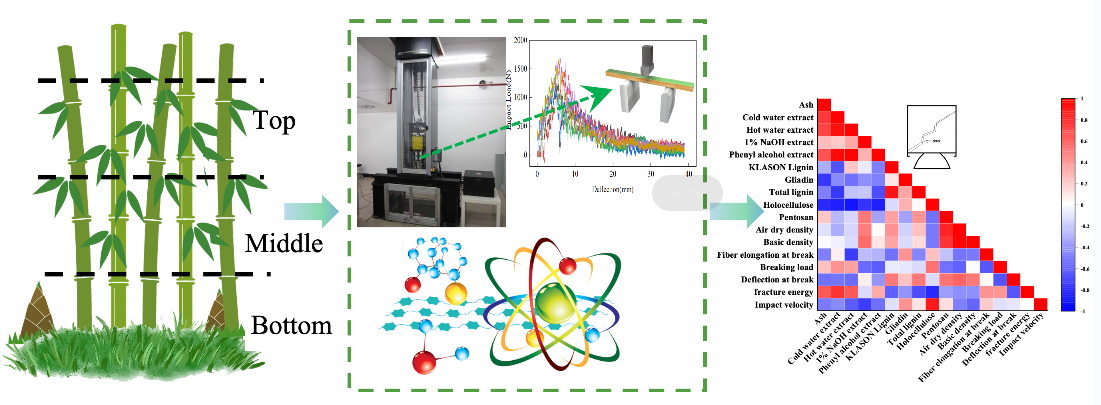 Open Access
Open Access
ARTICLE
Research on the Bending Impact Resistance and Transverse Fracture Characteristics of Bamboo under the Action of Falling Weight
1
Department of Biomaterials, International Centre for Bamboo and Rattan, Beijing, 100102, China
2
SFA and Beijing Co-Built Key Laboratory of Bamboo and Rattan Science & Technology, State Forestry Administration, Beijing,
100102, China
* Corresponding Author: Fengbo Sun. Email:
(This article belongs to the Special Issue: Functionalization of Wood and Bamboo-Based Materials)
Journal of Renewable Materials 2023, 11(1), 473-490. https://doi.org/10.32604/jrm.2022.023548
Received 01 May 2022; Accepted 20 June 2022; Issue published 10 August 2022
Abstract
Drop weight impact tester was used to accurately measure the bending impact resistance of various parts of Phyllostachys edulis, commonly known as moso bamboo, with a growth cycle of 3–8 years. Cellulose crystallinity in the bottom (B), middle (M) and top (T) of bamboo at different ages was calculated using peak height analysis in X-ray diffraction. Heatmap of Spearman correlation analysis was used to represent the correlation between chemical composition and impact mechanics. The breaking load (BL), fracture energy (FE) and impact deflection (ID) of 3–8-yearold bamboo were found to be in the range of ~670–2120 N, ~5.17–15.55 J, and ~3.60–~17.76 mm, respectively. As the growth period of bamboo rises, the cellulose crystallinity at the B and T decreases first and then increases, while that for the M increases first and then remains stable. Similarly, the bending impact performance of bamboo was found to become stable with its growth and age. The flexural impact and toughness of the 4-year-old bamboo base material were better than other specimens. The enhancement in the bending impact properties of bamboo at different growth periods was influenced by the lignin content, while the value of FE was mainly positively correlated with ash, cold and hot water extracts and benzyl alcohol content. However the content of holocellulose and pentosan, air-dry density and, base density negatively influenced the FE. With the change in the height of the bamboo, the correlation between its impact mechanical properties and chemical composition gradually decreased. This study provides data support and theoretical basis for the age-appropriate thinning and application of moso bamboo.Graphic Abstract

Keywords
Cite This Article
 Copyright © 2023 The Author(s). Published by Tech Science Press.
Copyright © 2023 The Author(s). Published by Tech Science Press.This work is licensed under a Creative Commons Attribution 4.0 International License , which permits unrestricted use, distribution, and reproduction in any medium, provided the original work is properly cited.


 Submit a Paper
Submit a Paper Propose a Special lssue
Propose a Special lssue View Full Text
View Full Text Download PDF
Download PDF Downloads
Downloads
 Citation Tools
Citation Tools